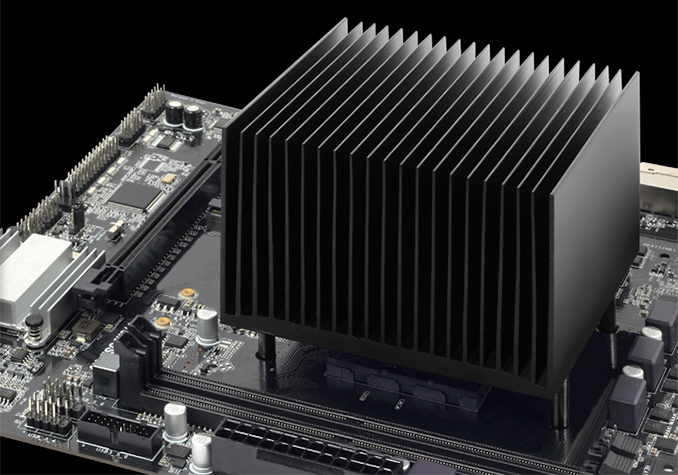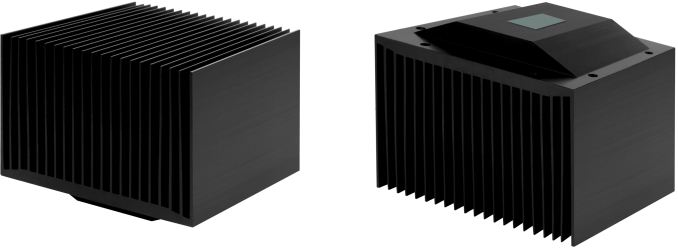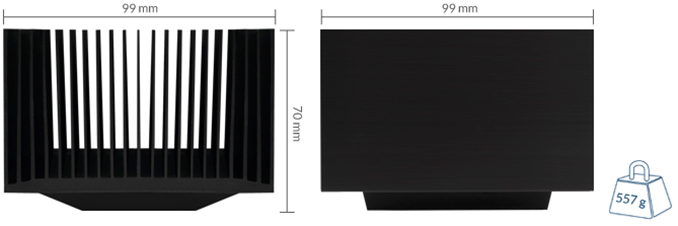Arctic Unveils Alpine AM4 Passive CPU Cooler
by Anton Shilov on May 25, 2018 4:00 PM EST- Posted in
- Cases/Cooling/PSUs
- AMD
- Passive Cooling
- AM4
- Ryzen
- Arctic
- Passive
- Alpine AM4

Arctic this week added its first passive cooler that is compatible with AMD’s AM4 processors into its lineup of products. The Alpine AM4 was designed for APUs and CPUs that dissipate no more than 47 W, which is common for modern mainstream chips that feature reduced TDP.
The Arctic Alpine AM4 passive cooler is made of black anodized aluminum, features 21 rather thick fins, and weighs 557 grams. The heat sink has a z-height of 81 mm and measures 100 × 100 mm on its sides, so it has to be installed into relatively spacious cases. Speaking of installation, it is worth mentioning that the Alpine AM4 ships with four screws with springs, so the installation of the device is fairly simple. To further things simplify, the cooling system comes with pre-applied MX-2 thermal compound. As a small bonus feature for those who want peace of mind, the passive cooler is covered by a six-year warranty as if a solid piece of aluminum could break down.
Arctic recommends to use the Alpine AM4 with AMD’s energy efficient APUs, such as the AMD’s Ryzen 3 2200 GE and Ryzen 5 2400GE, but the cooler will also handle AMD’s 65 W APUs and CPUs that can be programmed to limit their TDP to 46 W (at the cost of their frequency). Therefore, it is now possible to build a fanless PC based on a fairly wide range of AMD’s Ryzen 1000-series and 2000-series CPUs.
Arctic will start selling the Alpine AM4 passive coolers in the coming weeks. Pricing is not yet known, but judging by the simplistic construction of the product, do not expect it to cost significantly more than $20. In fact, Arctic’s currently-available Alpine passive coolers for Intel processors retail for €12.99 ($15.2) in Europe.
Related Reading
- Arctic Announces the Freezer 33 TR: An Air Cooler Designed for AMD’s Threadripper
- Cryorig Set to Reveal the Dual Heatpipe Frostbit M.2 SSD Cooler
- The Phononic HEX 2.0 TEC CPU Cooler Review
- Raijintek Shows Off Pumpless Liquid Cooling System
- Alpenföhn Unveils Olymp: A Giant Air Cooler Rated for 340W TDP
Source: Arctic (via FanlessTech)


















24 Comments
View All Comments
MrSpadge - Friday, May 25, 2018 - link
"As a small bonus feature for those who want a piece of mind"-> who want peace of mind
(English is not as brutal as it may sometimes sound)
Dragonstongue - Friday, May 25, 2018 - link
cool, but likely they could have increased the height of and "thinned out" the fins towards the top and even added a heatpipe or 2 to increase potential cooling so much more maybe even did a "crimped over" fin folding for a few mm towards the top of it to increase surface area that much more as well ^.^IMO $15 is not all that pricey, but the low TDP potential is not "great" when other HSF designs retail for slightly more for far greater potential, likely many that are say $30 "tower" style can operate in passive mode and still be quite functional..
makes me wonder why I have personally never seen a tower style cooler with the fins all fully vertical instead of horizontal this way here whatever heat is being generated is easily transported away, especially with heatpipes..conspiracy? LOL
jrs77 - Friday, May 25, 2018 - link
You can call it passive is, when no fan is needed. This thing however still needs airflow through the case to work, so it's not passive. It just doesn't have it's own fan, but uses the casefan.Death666Angel - Friday, May 25, 2018 - link
Passive doesn't mean "convection based" or whatever you seem to imply. It simply means what this thing is: no fan attached to the heatsink or the fan not being active (see: semi-passive modes of most modern PSUs).WorldWithoutMadness - Saturday, May 26, 2018 - link
so passive aggresive?Yomama6776 - Saturday, May 26, 2018 - link
The pizza was aggressiverocky12345 - Friday, May 25, 2018 - link
This thing looks like something I actually made way back when even before heat sinks were a thing. I made a heat sink out of Aluminum machined the fins and flat ground and then polished the base so it was smooth and shiny. I stuck a 90mm fan on it and used the 5 volt power it because at 12 volt it sounded like a hair dryer ( fans were much more powerful back then). The heat sink worked well on my 486 DX4 133Mhz@166MHz for the time it was very fast since nothing touched it until Intel released the first gen Consumer Pentium and got to 133Mhz which matched my chip@166MHz. Once Intel actually got to 166MHz I switched to that and ran it at 233MHz with the same cooler just had to change the mounting style which was easy.I can not believe something with the same size as to what I made is actually able to cool a modern chip with many core and a lot more speed under the hood. We sure have come a long way over the years and yet up until 2017 things were pretty stalled out for about 3 years.
mikato - Friday, June 15, 2018 - link
"I actually made way back when even before heat sinks were a thing"You must be pretty old.
Alistair - Friday, May 25, 2018 - link
You'd probably be better off buying any tower cooler, and taking off the fan, then using this, but a neat idea anyways. If they make a big enough one for the Ryzen 2200g that would be cool.hanselltc - Saturday, May 26, 2018 - link
Well it is cheap.